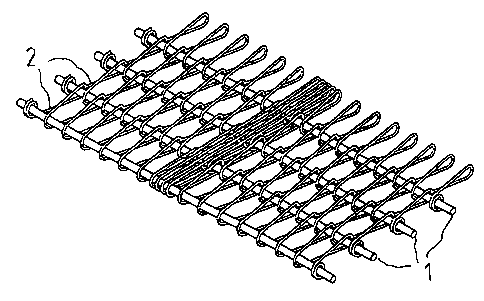Une partie des informations de ce site Web a été fournie par des sources externes. Le gouvernement du Canada n'assume aucune responsabilité concernant la précision, l'actualité ou la fiabilité des informations fournies par les sources externes. Les utilisateurs qui désirent employer cette information devraient consulter directement la source des informations. Le contenu fourni par les sources externes n'est pas assujetti aux exigences sur les langues officielles, la protection des renseignements personnels et l'accessibilité.
L'apparition de différences dans le texte et l'image des Revendications et de l'Abrégé dépend du moment auquel le document est publié. Les textes des Revendications et de l'Abrégé sont affichés :
| (12) Brevet: | (11) CA 2295033 |
|---|---|
| (54) Titre français: | BANDE TRANSPORTEUSE MAILLEE METALLIQUE |
| (54) Titre anglais: | A WIRE MESH CONVEYOR BELT |
| Statut: | Périmé et au-delà du délai pour l’annulation |
| (51) Classification internationale des brevets (CIB): |
|
|---|---|
| (72) Inventeurs : |
|
| (73) Titulaires : |
|
| (71) Demandeurs : |
|
| (74) Agent: | SMART & BIGGAR LP |
| (74) Co-agent: | |
| (45) Délivré: | 2007-08-28 |
| (86) Date de dépôt PCT: | 1998-06-22 |
| (87) Mise à la disponibilité du public: | 1998-12-30 |
| Requête d'examen: | 2003-04-03 |
| Licence disponible: | S.O. |
| Cédé au domaine public: | S.O. |
| (25) Langue des documents déposés: | Anglais |
| Traité de coopération en matière de brevets (PCT): | Oui |
|---|---|
| (86) Numéro de la demande PCT: | PCT/SE1998/001202 |
| (87) Numéro de publication internationale PCT: | SE1998001202 |
| (85) Entrée nationale: | 1999-12-21 |
| (30) Données de priorité de la demande: | ||||||
|---|---|---|---|---|---|---|
|
L'invention concerne une bande transporteuse comprenant, de chaque côté, une pluralité de maillons latéraux. Une pluralité de barres transversales relient les maillons latéraux par paires et un treillis métallique forme la surface de transport de la bande transporteuse. Le treillis métallique comprend également une pluralité de spirales, chaque spirale ayant des boucles encerclant deux des barres transversales. Au moins certaines spirales ont un pas variable sur la longueur des barres transversales.
A conveyor belt comprises a plurality of side links at each side of the
conveyor belt, a plurality of transverse rods connecting the
side links in pairs, and a wire mesh forming a conveying surface of the
conveyor belt. The wire mesh further comprises a plurality of
wire spirals each spiral having loops encircling two of the transverse rods.
At least some of the wire spirals have a varying pitch along the
length of the rods.
Note : Les revendications sont présentées dans la langue officielle dans laquelle elles ont été soumises.
Note : Les descriptions sont présentées dans la langue officielle dans laquelle elles ont été soumises.

2024-08-01 : Dans le cadre de la transition vers les Brevets de nouvelle génération (BNG), la base de données sur les brevets canadiens (BDBC) contient désormais un Historique d'événement plus détaillé, qui reproduit le Journal des événements de notre nouvelle solution interne.
Veuillez noter que les événements débutant par « Inactive : » se réfèrent à des événements qui ne sont plus utilisés dans notre nouvelle solution interne.
Pour une meilleure compréhension de l'état de la demande ou brevet qui figure sur cette page, la rubrique Mise en garde , et les descriptions de Brevet , Historique d'événement , Taxes périodiques et Historique des paiements devraient être consultées.
| Description | Date |
|---|---|
| Le délai pour l'annulation est expiré | 2015-06-22 |
| Lettre envoyée | 2014-06-23 |
| Accordé par délivrance | 2007-08-28 |
| Inactive : Page couverture publiée | 2007-08-27 |
| Inactive : Taxe finale reçue | 2007-06-05 |
| Préoctroi | 2007-06-05 |
| Un avis d'acceptation est envoyé | 2007-04-18 |
| Lettre envoyée | 2007-04-18 |
| Un avis d'acceptation est envoyé | 2007-04-18 |
| Inactive : Approuvée aux fins d'acceptation (AFA) | 2007-03-16 |
| Modification reçue - modification volontaire | 2006-06-09 |
| Inactive : CIB de MCD | 2006-03-12 |
| Inactive : Dem. de l'examinateur par.30(2) Règles | 2005-12-13 |
| Inactive : CIB attribuée | 2005-11-24 |
| Lettre envoyée | 2003-05-14 |
| Modification reçue - modification volontaire | 2003-05-05 |
| Requête d'examen reçue | 2003-04-03 |
| Exigences pour une requête d'examen - jugée conforme | 2003-04-03 |
| Toutes les exigences pour l'examen - jugée conforme | 2003-04-03 |
| Inactive : Page couverture publiée | 2000-02-29 |
| Inactive : CIB en 1re position | 2000-02-25 |
| Lettre envoyée | 2000-02-10 |
| Inactive : Notice - Entrée phase nat. - Pas de RE | 2000-02-10 |
| Demande reçue - PCT | 2000-02-04 |
| Demande publiée (accessible au public) | 1998-12-30 |
Il n'y a pas d'historique d'abandonnement
Le dernier paiement a été reçu le 2007-05-31
Avis : Si le paiement en totalité n'a pas été reçu au plus tard à la date indiquée, une taxe supplémentaire peut être imposée, soit une des taxes suivantes :
Les taxes sur les brevets sont ajustées au 1er janvier de chaque année. Les montants ci-dessus sont les montants actuels s'ils sont reçus au plus tard le 31 décembre de l'année en cours.
Veuillez vous référer à la page web des
taxes sur les brevets
de l'OPIC pour voir tous les montants actuels des taxes.
Les titulaires actuels et antérieures au dossier sont affichés en ordre alphabétique.
| Titulaires actuels au dossier |
|---|
| FRIGOSCANDIA EQUIPMENT AB |
| Titulaires antérieures au dossier |
|---|
| INGEMAR FRODERBERG |